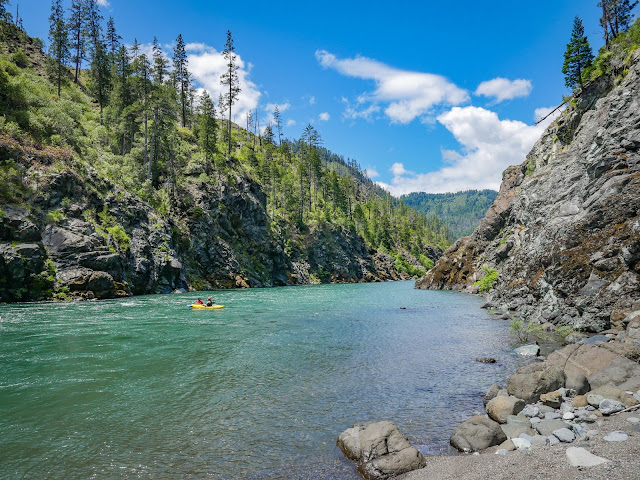Stream: Indigo Creek is yet another high quality tributary of the Illinois River, entering from river right 3 miles above the take out at Oak Flat. Many a boater have floated by on the Illinois, looked upstream and considered what lay up there.
The barrier to running this creek is logistical. The access road "Bear Camp" goes up to an elevation of almost 4800', making it rare that there is water in the creek, yet no snow on the road.
After watching conditions for a few years, and passing up an opportunity or two in the middle of Winter (we were going to run the creek as an overnight trip), there was a unique opportunity late in the spring of 2020 after the snow had melted, in the form of a large, warm rainstorm.
Priscilla, Joseph and I added to the complex logistics by starting our trip off with a run down the Illinois, and meeting the other half of our group at the take out for the Illinois, setting shuttle and heading straight up for Indigo the next day.
Aside from having a nice trip down the Illinois, we had the benefit of being able to check water levels on Indigo as we floated by, and walking up it a short way.
It looked like enough water to us, but on the low side. We continued to the take out, said good bye to the Illinois group, and hello to Ben Mckenzie and Yann Crist-evans, who would be joining us as part of the Indigo group.
We camped at Oak Flat that night, amid a soft rain that we crossed our fingers would keep levels on Indigo from dropping much overnight. The next morning we drove up towards the put in to meet Zach Collier high up on Bear Camp Road. We were pleased with how the logistics were working out, given they had been put in to action 3 days before and there had been no cell contact since. Zach had found the put in road to be un-gated on his drive up, so after stretching our legs we drove down to NF-2411 and began a descent into the Indigo drainage. We were happy we hadn't been stopped by a gate, but these old Kalmiopsis roads are always hit or miss as far as their condition, and usually come with their own set of obstacles. We were glad we had a chainsaw along, and Joseph was making good use of it clearing the path. We would have had a long walk without one.
The walk in was pretty cushy for a 1,000 vertical foot cross-country descent, moving downhill at an easily walkable-able grade with stable footing through a recently burned area with minimal brush. Photo: Priscilla Macy
Photo: Priscilla Macy
We were aiming for the confluence of the EF of Indigo Creek, and Breezy Creek as our put in. The last 50' to the creek the hard shellers lowered our boats with a rope, though Zach found a different way down with his packraft that didn't need any rope. We found ourselves at water level about 50 yards upstream of the Breezy confluence. Photo: Priscilla Macy
Photo: Priscilla Macy
We had chosen the East Fork as our access to the drainage and were glad we did, but would probably choose a different route next time. There are cross-country routes to the West Fork, or nearer the confluence of the EF/WF Indigo.
----------------------------------------------------------------------------------------------------------------------
You can read about our trip down the East Fork of Indigo Creek here.
-----------------------------------------------------------------------------------------------------------------------
*keep scrolling for Indigo Creek
 Photo: Priscilla Macy
Photo: Priscilla Macy
------------------------------------------------------------------------------------------------------------------------
Back to Indigo Creek.
-----------------------------------------------------------------------------------------------------------------------
 Photo: Yann Crist-Evans
Photo: Yann Crist-EvansFlows: We paddled Indigo Creek May 18-19 of 2020.
Access: Access to a put in is difficult for Indigo Creek. Options are abundant, but all spur off of Bear Camp road and require driving to 4800'. Snow will typically be the largest barrier to running this creek in any given year.
----------------------------------------------------------------------------------------------------------------------------------------------







































